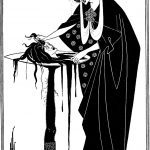Welcome to the vibrant world of Polish Art Nouveau, where artistic expression flourished in the late 19th and early 20th centuries. A fusion of intricate designs, flowing lines, and a celebration of nature defined the works of these talented creators. From the versatile Stanisław Wyspiański to the visionary architect Antoni Madeyski, each artist on this list played a crucial role in shaping the distinctive aesthetic of Art Nouveau in Poland. Join us on a journey through the captivating artworks and architectural wonders that embody the spirit of this enchanting artistic movement.
- Stanisław Wyspiański: Stanisław Wyspiański, a polymath of the Young Poland movement, not only left an indelible mark in painting but also contributed significantly to literature and theater design. His stained glass windows in the Franciscan Church in Kraków exemplify his mastery of the Art Nouveau style, blending symbolism with organic forms.
- Józef Mehoffer: Józef Mehoffer, known for his exquisite decorative painting and stained glass works, was a prominent figure in the Art Nouveau movement. His collaboration with Stanisław Wyspiański on the stained glass windows of the Church of St. Stanislaus in Kraków showcases the harmonious fusion of their artistic visions.
- Władysław Podkowiński: Władysław Podkowiński, a painter associated with symbolism and Art Nouveau, created the iconic “Frenzy of Exultations,” a masterpiece that encapsulates the tumultuous emotions of the era. His innovative use of color and form marked him as a visionary within the movement’s circles.
- Kazimierz Sichulski: Kazimierz Sichulski, an architect with a penchant for the Art Nouveau style, left an enduring legacy through his architectural designs and contributions to the decorative arts. His work reflects the essence of Art Nouveau, emphasizing fluid lines and ornate details.
- Antoni Madeyski: Antoni Madeyski, an architect and artist, played a pivotal role in shaping the Art Nouveau movement in Poland. His architectural designs, characterized by sinuous lines and intricate details, contributed to the visual richness of the period.
- Tadeusz Stryjeński: Tadeusz Stryjeński, an architect with a passion for Art Nouveau, left an indelible mark on the architectural landscape of the early 20th century. His designs embodied the principles of the movement, with a focus on organic forms and decorative elements.
- Fryderyk Pautsch: Fryderyk Pautsch, an architect with a penchant for Art Nouveau and Secessionist styles, made significant contributions to the architectural scene in Warsaw. His designs, characterized by ornate detailing and innovative forms, reflect the dynamism of the Art Nouveau movement.
- Leon Wyczółkowski: Leon Wyczółkowski, primarily associated with symbolism, also showcased Art Nouveau influences in some of his works. His paintings, marked by a harmonious blend of natural elements and symbolic imagery, resonate with the spirit of the era.
- Franciszek Bielecki: Franciszek Bielecki, a painter and illustrator, left a visual legacy infused with Art Nouveau aesthetics. His works, characterized by flowing lines and intricate details, exemplify the artistic principles of the movement.
- Konrad Krzyżanowski: Konrad Krzyżanowski, an architect who contributed to the movement in the early 20th century, left an imprint on the architectural landscape of Poland. His designs reflected the innovative and ornamental characteristics of Art Nouveau, contributing to the visual richness of the era.
As we bid farewell to these visionary Polish Art Nouveau artists, let their creations continue to enchant and inspire. Their mastery of intricate designs, organic forms, and harmonious details has left an indelible mark on the artistic landscape of Poland. Each artist’s contribution resonates with the spirit of a bygone era. Let us celebrate their enduring legacy and carry forward the appreciation for the enchanting world they crafted with passion and creativity.




